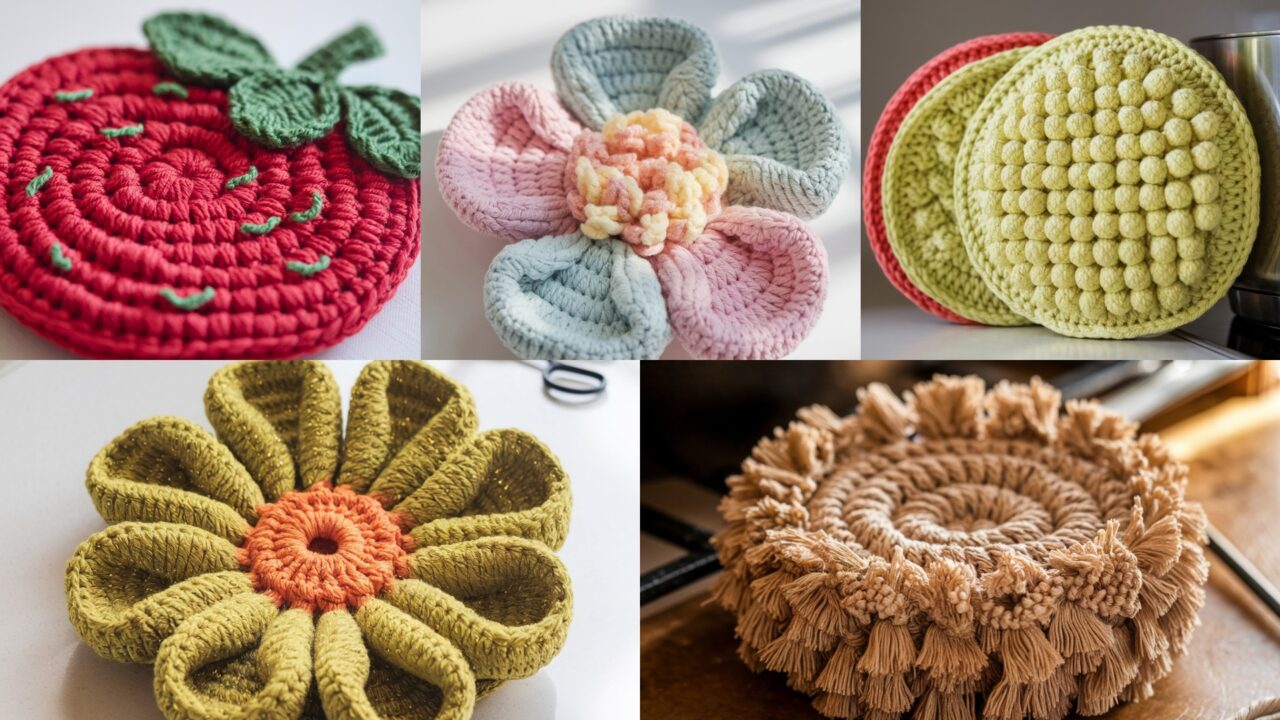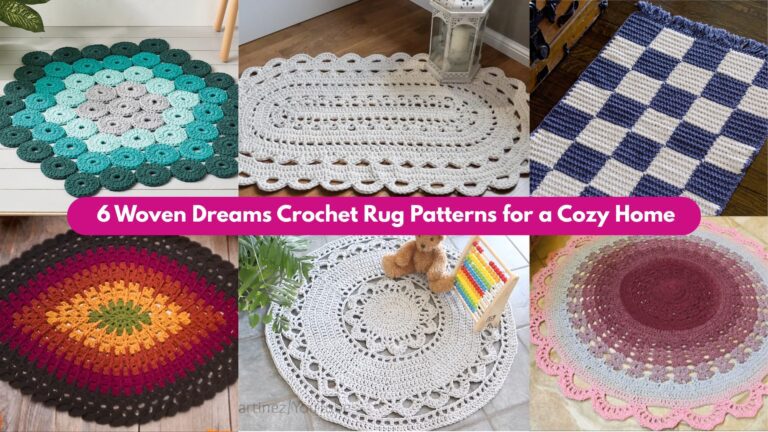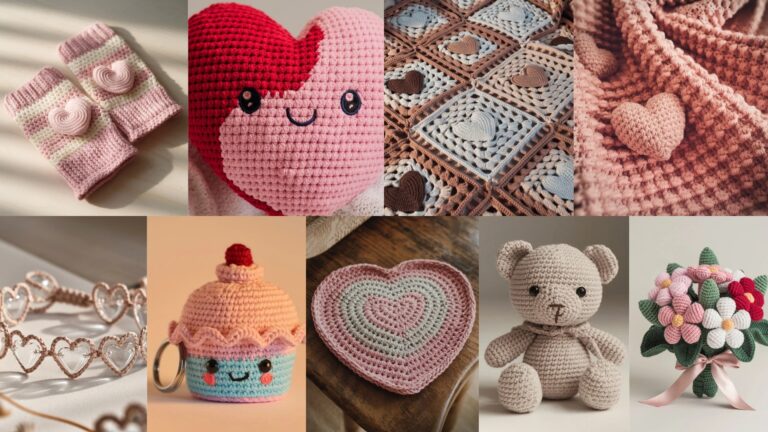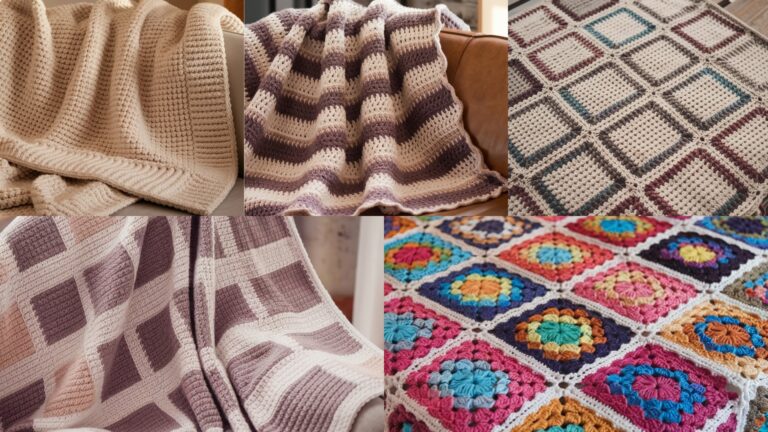You want scrubby projects that actually do something useful — clean dishes, buff away dead skin (if you use the right yarn), or look cute beside the sink without falling apart after three washes. Great. Scrubbies are fast, satisfying, use small amounts of yarn or cord, teach basic crochet skills, and make perfect gifts.
Below you’ll find five beginner-friendly scrubby patterns with full step-by-step instructions, materials lists, stitch counts, finishing notes, texture options, and washing/care tips. I’ll also give you a quick primer on which yarns to use (so you don’t accidentally make a face scrubby out of hemp), finishing techniques, and maintenance advice. Make one tonight. Your sink will behave better.
Quick notes before you start (read this or regret later)
- Skill level: Beginner → confident beginner. All patterns keep stitches simple.
- Yarn choices:
- Nylon/scrubby yarn (tulle style) — best for dishes and heavy scrubbing; dries fast and resists mildew.
- Hemp cord / natural hemp twine — extremely durable and abrasive; perfect for pots, pans, grout. Not for nonstick cookware or face.
- Cotton (100% cotton or cotton DK) — softer; suitable for body/face scrubby and eco-friendly dish scrubbers when gentleness is desired.
- Hooks: Match to yarn. Typical range: 3.0–8.0 mm depending on thread/cord thickness. I’ll recommend per pattern.
- Abbreviations (US): ch = chain, sl st = slip stitch, sc = single crochet, hdc = half double crochet, dc = double crochet, tr = treble, inc = 2 sc in same stitch, dec = sc2tog, rnd = round.
- Care: Rinse after use, squeeze out water, hang to dry. Machine wash in a mesh bag OK sometimes; air-dry. Replace when fibers break down or smell persists.
1. Crochet Flower Scrubby Pattern
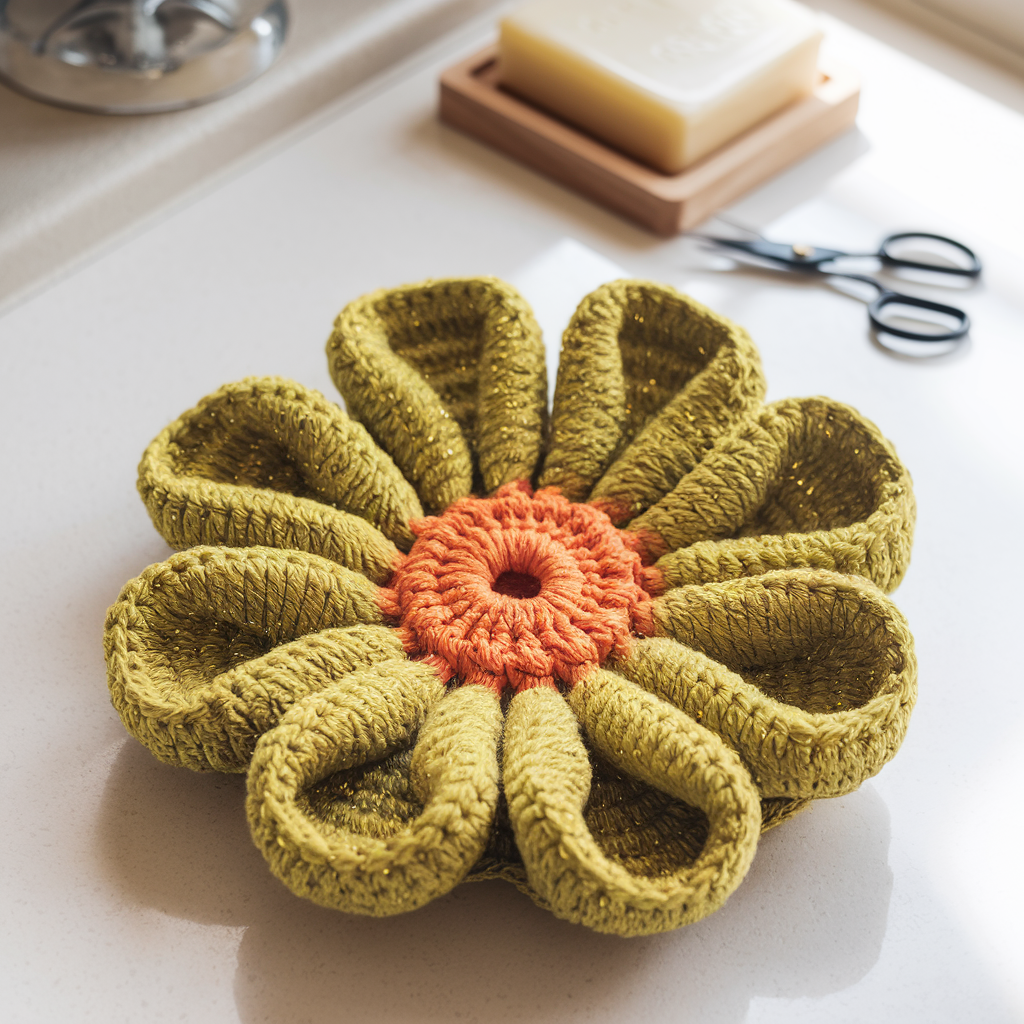
Skill level: Beginner
Finished size: ≈ 3.5–4.5 in diameter (depends on yarn & hook)
Best for: Cute sink scrubby, gentle exfoliation (with cotton), soap-pocket decoration.
Materials
- Scrubby nylon yarn or cotton for gentler version.
- 3.5 mm (E) hook for nylon; 3.0 mm for cotton.
- Yarn needle, scissors.
Stitches used
magic ring (or ch-loop start), ch, sc, hdc, dc, sl st.
Pattern — step by step
- Center ring: Create a magic ring or ch4 and sl st to form a small ring.
- Rnd 1 (center): Ch1, work 8 sc into the ring. Pull tight; sl st to first sc. (8 sc)
- Rnd 2 (petal bases): ch2, skip next sc, sl st in next sc — repeat 8 times to make 8 small chain loops. Join.
- Rnd 3 (petals): Into each chain loop work: (sc, hdc, 3 dc, hdc, sc). Repeat for all loops and join with sl st. This creates full, rounded petals.
- Rnd 4 (reinforce back): Sl st to the underside and work sc around the base of petals (in the gaps) to create a stable backing; do a second sc round for extra body if you want it thicker.
- Finish: Fasten off, weave ends, trim. Add a small ch10 loop at final join for hanging, if desired.
Tips & variations
- For a face pad, use soft cotton and smaller hook — reduce dc counts (try 2 dc instead of 3) for gentler texture.
- Make two flowers and sew together for a thicker double-sided scrubby (one soft, one rough).
- Add a soap pocket: make two flowers and join leaving a small opening, insert soap, sew closed.
Care
Rinse out soap, squeeze, hang to dry. Machine wash in a mesh bag occasional; air dry.
2. Crochet Suzie Flower Face Scrubby Pattern
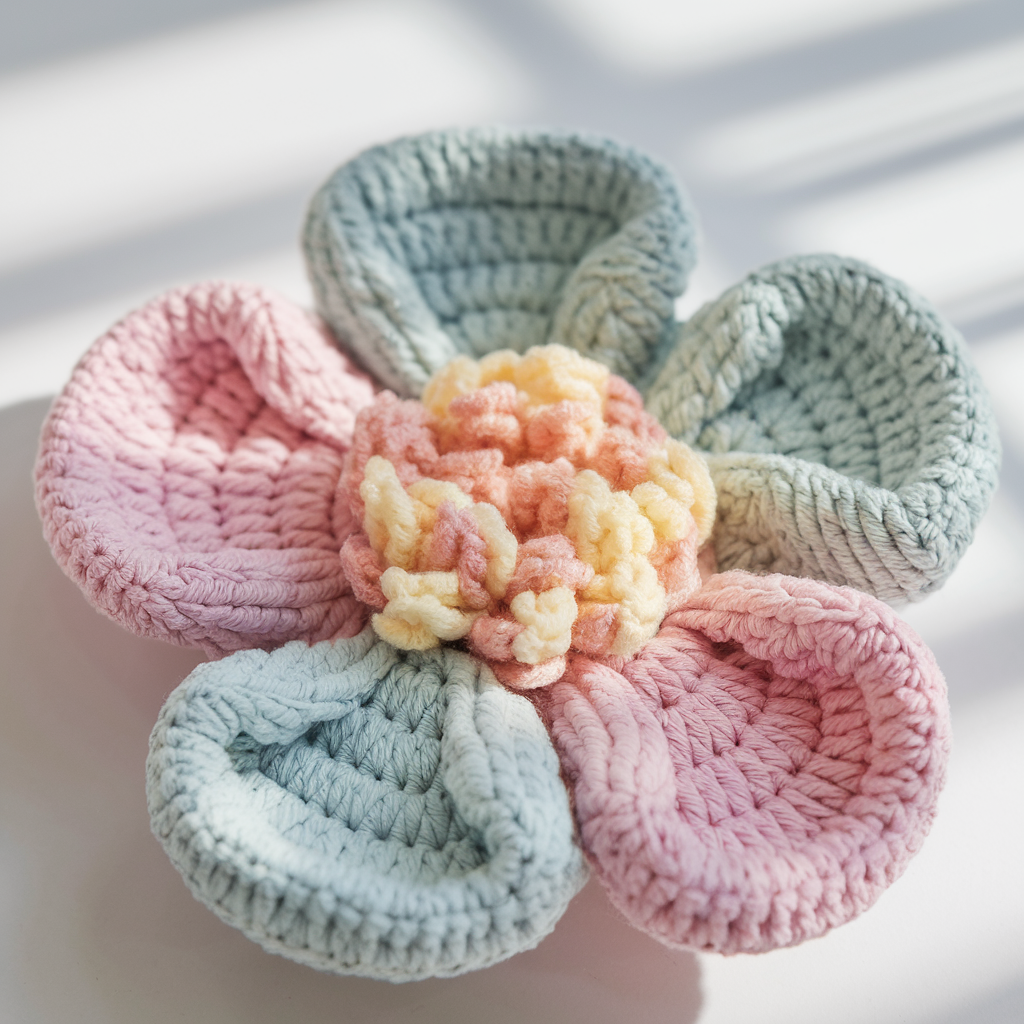
Small, nubby, textural — great for gentle face or body exfoliation (use soft cotton).
Skill level: Beginner–confident beginner
Finished size: ≈ 3–3.5 in across
Best for: Facial exfoliation when made from 100% cotton.
Materials
- 100% cotton DK or cotton-blend yarn.
- 3.0–3.5 mm hook.
- Yarn needle, scissors.
Stitches used
magic ring, ch, sc, dc, puff stitch (or bobble), sl st.
Pattern — step by step
- Center: Magic ring; ch2 (counts as dc), work 11 dc into ring; join. (12 dc)
- Rnd 2: Ch1, sc in next st, ch3 — repeat around to make ch-3 loops for petals; join.
- Rnd 3 (puffed petals): Into each ch3 loop make a puff stitch (yo, insert, pull loop — repeat to desired puff height; pull through all loops, ch1), then sl st to base. Repeat for every loop.
- Rnd 4 (backing): Flip work and sc around through back loops or through both layers to create a stable texture on the underside. Join and fasten off.
- Finish: Weave in tails.
Tips
- Puff stitch size controls exfoliation strength: smaller puff = gentler.
- Make two and sew together for double thickness. Use cotton if hitting the face.
Care
Machine wash cotton scrubby in a laundry bag and air dry. Replace when puffs flatten or integrity weakens.
3. Crochet Large Reusable Scrubby Pattern
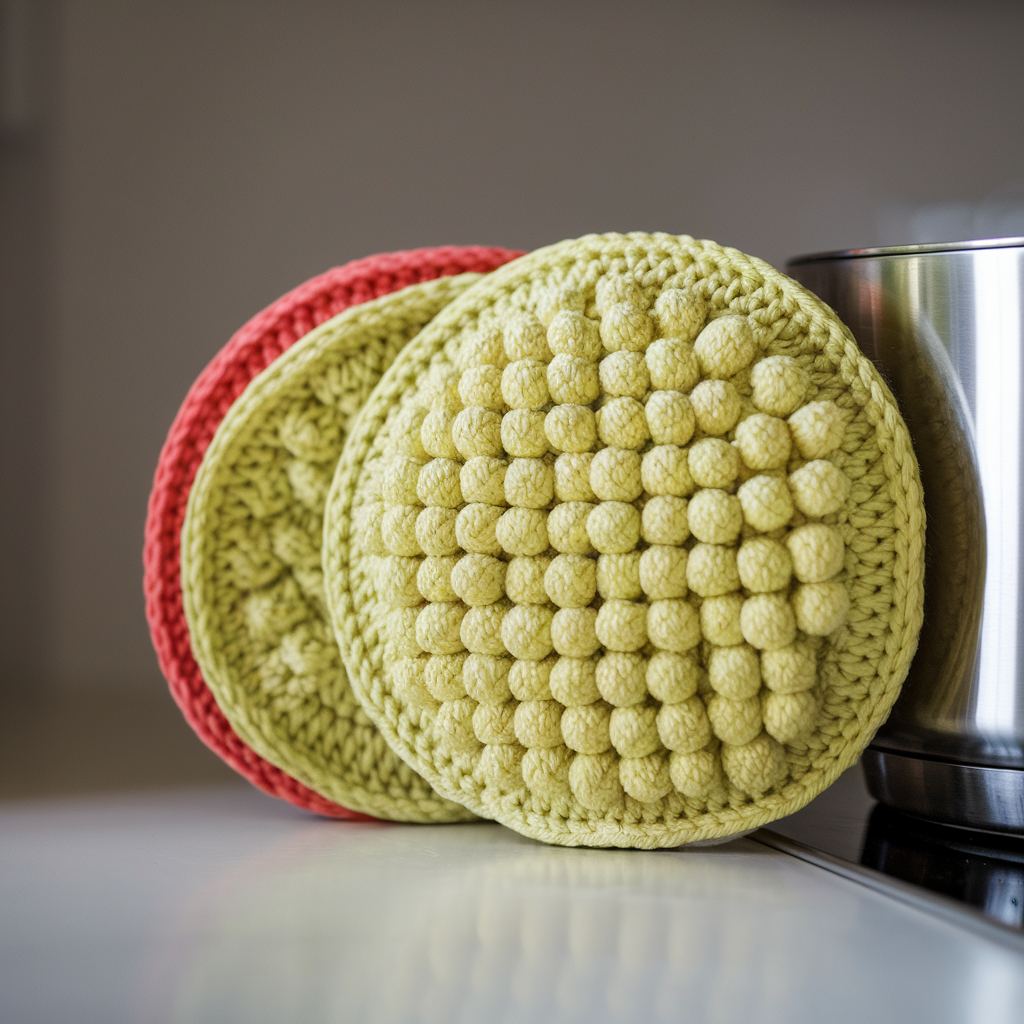
Big, loopy, and designed for pots—use scrubby nylon or layered construction for extra life.
Skill level: Confident beginner
Finished size: ≈ 6–7 in diameter (single) or larger if you want a pocket.
Best for: Pots, pans, shower scrubbing, heavy use.
Materials
- Scrubby nylon yarn (scrubbing tulle) or bulky cotton if you prefer gentler.
- 5.0 mm hook (or whatever your yarn label suggests).
- Yarn needle, scissors.
Stitches used
ch, sc, inc, sl st, dc (optional), clusters/popcorns (optional).
Pattern — step by step (single thick disc)
- Start: ch4, join with sl st to form ring. Ch1.
- Rnd 1: 12 sc into ring; join. (12 sc)
- Rnd 2: ch1, inc in each st around — 24 sc; join.
- Rnd 3: ch1, sc in next st, inc in next — 36 sc; join.
- Rnd 4: ch1, sc in next 2, inc — 48 sc; join.
- Continue increasing as needed until diameter reaches target (follow same pattern: each round increases the spacing between increases by 1).
- Add body: Once diameter is reached, work 4–8 rounds of sc (no increases) to add loft. More rounds = thicker scrubby.
- Optional texture: Add
*sc, ch1, 5 dc in next st, ch1, sc*spaced around to create rough clusters if you want extra abrasion. Use sparingly with nylon. - Finish: sl st to join, weave a long tail and lock off by threading tail through the final rounds multiple times. Trim.
Pocket version (two-layer)
- Make two discs equal size. Align and whipstitch around the edges, leaving a 2–3 in gap to turn. Turn and finish seam. Optionally stuff with yarn scraps for loft. Close seam.
- Or make discs right-sides-together and sc around edge leaving a gap to turn, then finish.
Tips
- Clarify monthly if you use heavy grease.
- Hang to dry; nylon dries quickly. Don’t leave in a watery sink.
4. Crochet Hemp Scrubby Pattern
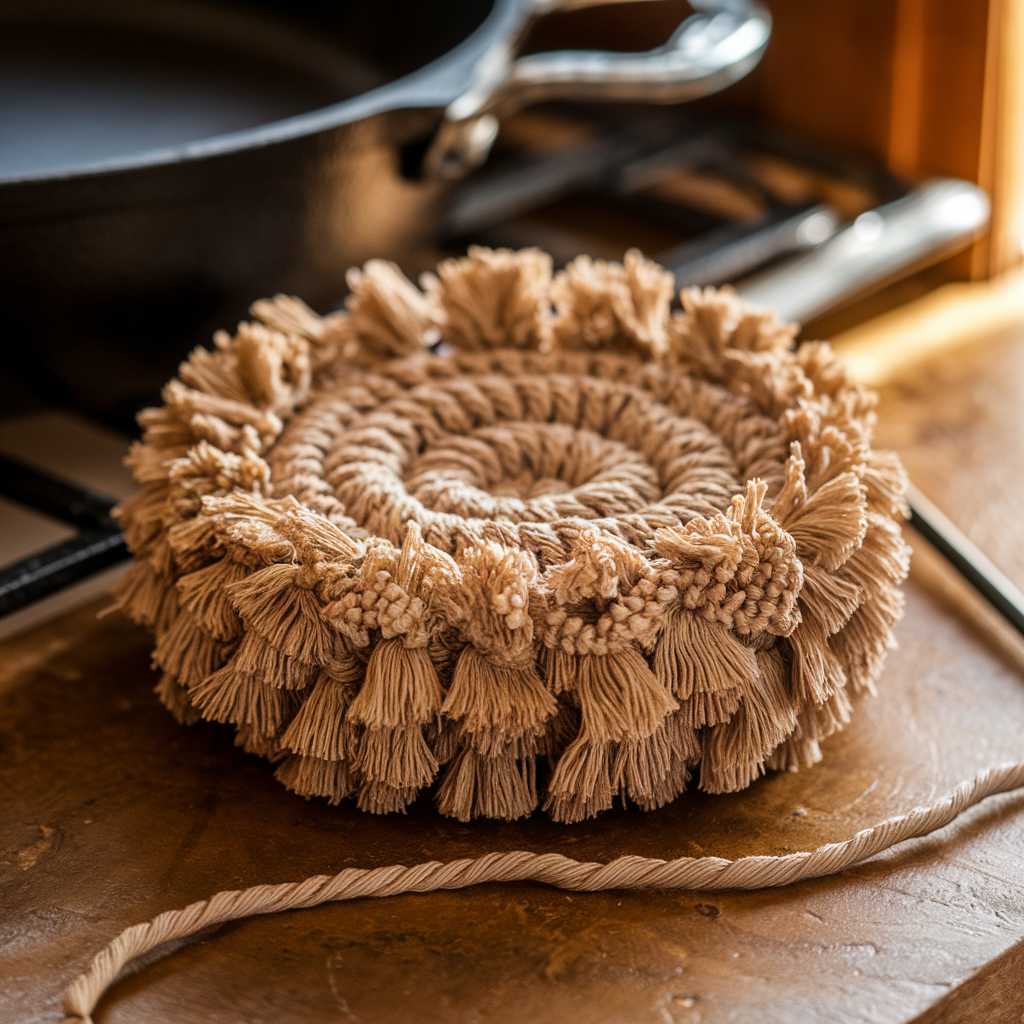
You asked for hemp specifically — sturdy, eco, and aggressive. This is the one your nonstick pan fears. Don’t use this on delicate cookware or for face exfoliation.
Skill level: Beginner (sturdy single crochet rounds)
Finished size: ≈ 4–6 in diameter (depends on cord & hook)
Best for: Cast iron, stainless steel, grout, heavy scrubbing tasks.
Materials
- Hemp cord (natural hemp twine; 2–4 mm recommended) — ~15–30 yards.
- Crochet hook sized to cord: 4.0–6.5 mm (G–K) for thinner cord; 6.5–8.0 mm for thicker rope.
- Yarn needle, scissors.
Abbreviations (US)
ch, sc, inc, dec, sl st, rnd.
Pattern — step by step
- Center loop: ch3 and sl st to form a ring or use a small loop/magic ring technique.
- Rnd 1: Work 6 sc into the ring; sl st to join. (6 sc)
- Rnd 2: ch1, inc in each st around → 12 sc; join.
- Rnd 3: ch1, sc in next st, inc in next repeat → 18 sc; join.
- Rnd 4: ch1, sc in next 2, inc → 24 sc; join.
- Rnd 5: ch1, sc in next 3, inc → 30 sc; join.
- Continue increasing until scrubby reaches desired diameter (increase spacing between inc stitches by 1 each round).
- Add body: Work 4–8 rounds sc without increases to add thickness.
- Optional extra texture: add a textured round (popcorns/clusters) — hemp is already abrasive so use sparingly.
- Finish: sl st, leave 6–8 in tail, weave tail back through several stitches and knot or backstitch to secure. Trim tail.
Variations
- Hemp + cotton liner: make a slightly smaller cotton disc and stitch it inside the hemp disc for a softer inner surface and removable liner.
- Hemp mitt: build a palm disc (3.5–4 in), then work rounds up for a cuff (10–12 rounds) to create a pocket for your hand.
Hemp tips
- Hemp frays — don’t burn the ends. Weave them back or secure with a dab of fabric glue.
- Tension: hemp is stiff. If rounds are too tight, go up a hook size.
- Avoid nonstick pans — hemp will abrade them.
Care
Rinse well, hang to dry. Machine wash inside a mesh bag occasionally; air dry. If mildew appears, soak in vinegar solution (1:4 water:vinegar), rinse, dry in sun.
5. Crochet Strawberry Scrubby Pattern
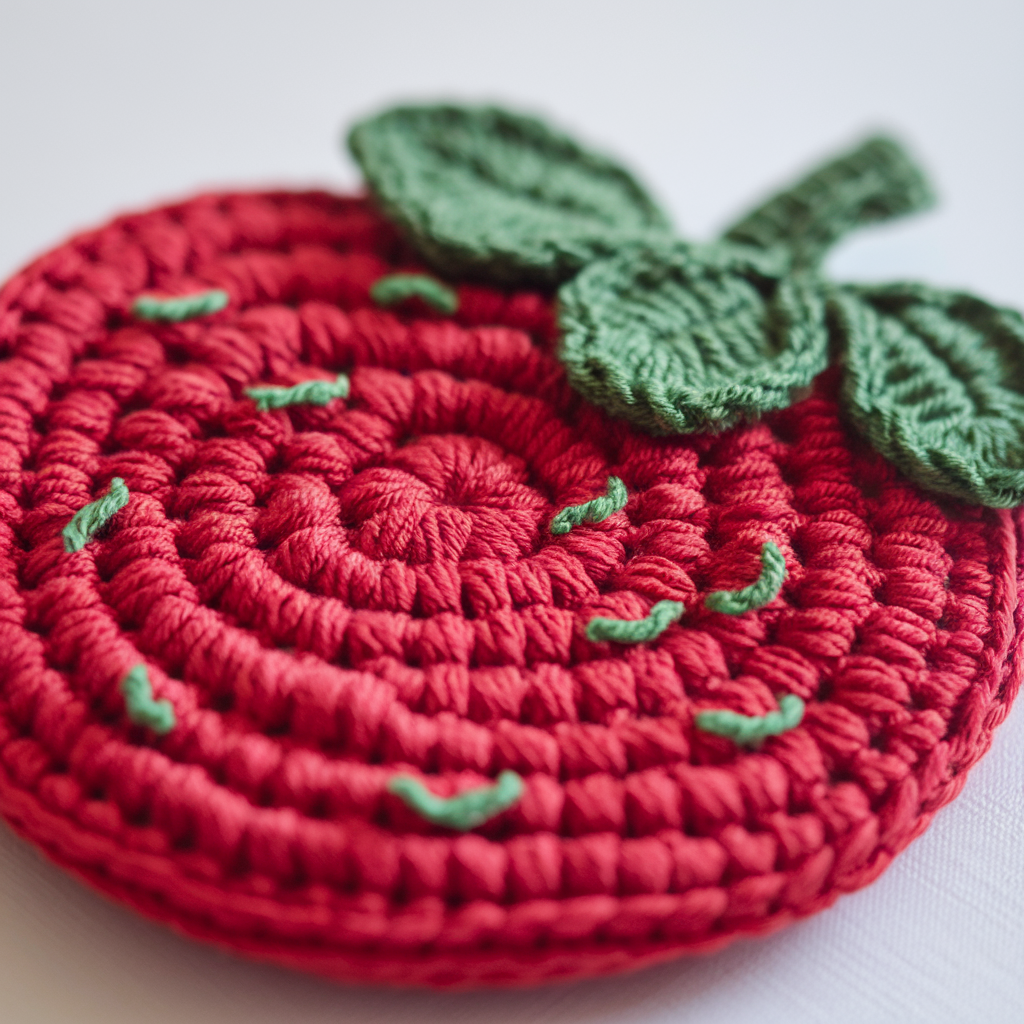
Cute and functional — a strawberry scrubby doubles as a soap pocket or hostess gift when made with cotton or nylon.
Skill level: Beginner–Confident beginner
Finished size: ≈ 3.5–4.5 in tall
Best for: Cute dish scrubby or soap cozy (cotton interior recommended).
Materials
- Red scrubby yarn (or cotton for gentleness), small amount of green yarn for leaves.
- 3.5–4.0 mm hook (adjust by yarn).
- Yarn needle, scissors, optional yarn scraps for stuffing (if making a stuffed soap pocket).
Stitches used
magic ring, sc, inc, dec, sl st, ch.
Pattern — step by step
Body
- Magic ring. Rnd1: 6 sc in ring; join. (6 sc)
- Rnd2: inc each st → 12 sc; join.
- Rnd3: (sc, inc) around → 18 sc; join.
- Rnd4–6: sc around (18 sc) for height. Join each round.
- Rnd7 (narrowing): (sc, dec) around → 12 sc; join.
- Rnd8: dec around → 6 sc; close. Stuff lightly if you want a plush shape or keep flat for a pad. Finish and fasten off.
Leaves
- With green yarn, ch6, sc in 2nd ch from hook and across (5 sc), ch1, turn; sc back across to create a small leaf. Make 4–6 leaves and sew to top of strawberry. Alternatively, crochet small pointed leaves (ch4, sl st at base) and arrange.
Assembly
- Option A: leave flat and use as scrubby.
- Option B: make two halves and sew together leaving pocket to slip a bar of soap inside.
Tips
- Add tiny seed details with yellow embroidery thread (French knots) for cuteness — avoid beads for dish scrubbers.
- Make a set: strawberry + leaf soap pocket as a gift.
Care
Rinse, hang dry. Wash cotton liners separately if used.
Finishing & Universal Tips (applies to every scrubby above)
- Hanging loop: Add a small ch8–12 loop before finishing to hang scrubby to dry upright.
- Double up: Two thin discs sewn together last longer than a single thick disc — redundancy wins in dish duty.
- Avoid cross-contamination: Keep a designated scrubby for dishes, another for body. Color-code if you’re forgetful.
- Replacement: Replace when fibers fray, smell persists after washing, or the scrubby falls apart — they’re cheap to make, don’t overcomplicate it.
- Gift idea: Pair a scrubby with a bar of eco soap inside a soap pocket (strawberry or join discs) and you have an instant handmade present.
Washing & Care Summary
- Rinse after use with hot water, squeeze out excess water.
- Machine wash in a mesh laundry bag occasionally (gentle cycle). Avoid high-heat drying.
- Air dry fully between uses — mildew hates airflow and sunlight.
- Sanitize as needed by soaking briefly in vinegar solution (1:4 water to vinegar) or at the top rack of the dishwasher (check your yarn’s heat tolerance). Don’t overdo heat on hemp or nylon.
Conclusion
There. Five complete scrubby patterns — each written for beginners and crafted to be useful, not just decorative. Pick your fiber for the job: nylon for dishes, hemp for heavy scrubbing, cotton for skin and eco sugariness. Make one tonight, hang it to dry, and your sink (and maybe your conscience) will look better.


